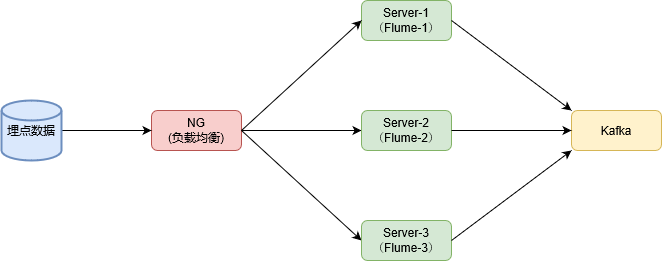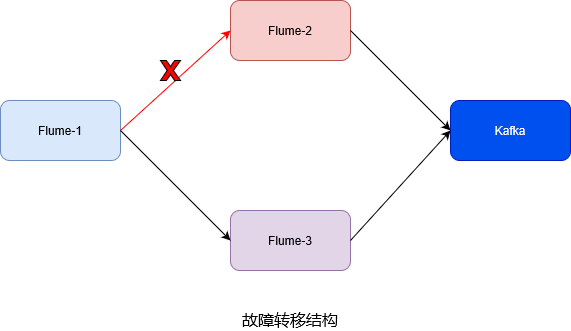Flume——开发案例
主要内容:
- 介绍几种常见的Flume使用场景下,如何配置相关的配置文件
监控端口数据发送到控制台
source:netcat
channel:memory
sink:logger
# Name the components on this agent
a1.sources = r1
a1.sinks = k1
a1.channels = c1
# Describe/configure the source
a1.sources.r1.type = netcat
a1.sources.r1.bind = localhost
a1.sources.r1.port = 44444
# Describe/configure the channel
a1.channels.c1.type = memory
a1.channels.c1.capacity = 1000
a1.channels.c1.transactionCapacity = 100
# Describe/configure the sink
a1.sinks.k1.type = logger
# Bind the source and sink to the channel
a1.sources.r1.channels = c1
a1.sinks.k1.channel = c1
实时读取本地文件到HDFS
方案一:(存在重复数据的风险)
source:exec
channel:file
sink:hdfs
# Name the components on this agent
a1.sources = r1
a1.sinks = k1
a1.channels = c1
# Describe/configure the source
a1.sources.r1.type = exec
a1.sources.r1.command = tail -F /opt/module/hive/logs/hive.log
a1.sources.r1.shell = /bin/bash -c
# Describe/configure the channel
a1.channels.c1.type = file
a1.channels.c1.checkpointDir = /mnt/flume/checkpoint
a1.channels.c1.dataDirs = /mnt/flume/data
# Describe/configure the sink
a1.sinks.k1.type = hdfs
a1.sinks.k1.hdfs.path = hdfs://ip:host/flume/%Y%m%d/%H
#上传文件的前缀
a1.sinks.k1.hdfs.filePrefix = logs-
#是否按照时间滚动文件夹
a1.sinks.k1.hdfs.round = true
#多少时间单位创建一个新的文件夹
a1.sinks.k1.hdfs.roundValue = 1
#重新定义时间单位
a1.sinks.k1.hdfs.roundUnit = hour
#是否使用本地时间戳
a1.sinks.k1.hdfs.useLocalTimeStamp = true
#积攒多少个 Event 才 flush 到 HDFS 一次
a1.sinks.k1.hdfs.batchSize = 1000
#设置文件类型,可支持压缩
a1.sinks.k1.hdfs.fileType = DataStream
#多久生成一个新的文件
a1.sinks.k1.hdfs.rollInterval = 600
#设置每个文件的滚动大小
a1.sinks.k1.hdfs.rollSize = 134217700
#文件的滚动与 Event 数量无关
a1.sinks.k1.hdfs.rollCount = 0
#最小冗余数
a1.sinks.k1.hdfs.minBlockReplicas = 1
# Bind the source and sink to the channel
a1.sources.r1.channels = c1
a1.sinks.k1.channel = c1
方案二:(安全,不丢数据)
source:TAILDIR
channel:file
sink:hdfs
# Name the components on this agent
a1.sources = r1
a1.channels = c1
a1.sinks = k1
# Describe/configure the source
a1.sources.r1.type = TAILDIR
a1.sources.r1.positionFile = /var/log/flume/taildir_position.json
a1.sources.r1.filegroups = f1 f2
a1.sources.r1.filegroups.f1 = /var/log/test1/example.log
a1.sources.r1.filegroups.f2 = /var/log/test2/.*log.*
a1.sources.r1.fileHeader = true
a1.sources.ri.maxBatchCount = 1000
# Describe/configure the channel
a1.channels.c1.type = file
a1.channels.c1.checkpointDir = /mnt/flume/checkpoint
a1.channels.c1.dataDirs = /mnt/flume/data
# Describe/configure the sink
a1.sinks.k1.type = hdfs
a1.sinks.k1.hdfs.path = /flume/events/%y-%m-%d/%H%M/%S
a1.sinks.k1.hdfs.filePrefix = FlumeData-
a1.sinks.k1.hdfs.round = true
a1.sinks.k1.hdfs.roundValue = 10
a1.sinks.k1.hdfs.roundUnit = minute
# Bind the source and sink to the channel
a1.sources.r1.channels = c1
a1.sinks.k1.channel = c1
实时读取目录下文件到HDFS
source:spooldir
channel:file
sink:hdfs
# Name the components on this agent
a1.sources = r1
a1.sinks = k1
a1.channels = c1
# Describe/configure the source
a1.sources.r1.type = spooldir
a1.sources.r1.spoolDir = /opt/module/flume/upload
a1.sources.r1.fileSuffix = .COMPLETED
a1.sources.r1.fileHeader = true
# Describe/configure the channel
a1.channels.c1.type = file
a1.channels.c1.checkpointDir = /mnt/flume/checkpoint
a1.channels.c1.dataDirs = /mnt/flume/data
# Describe/configure the sink
a1.sinks.k1.type = hdfs
a1.sinks.k1.hdfs.path = hdfs://ip:host/flume/upload/%Y%m%d/%H
#上传文件的前缀
a1.sinks.k1.hdfs.filePrefix = upload-
#是否按照时间滚动文件夹
a1.sinks.k1.hdfs.round = true
#多少时间单位创建一个新的文件夹
a1.sinks.k1.hdfs.roundValue = 1
#重新定义时间单位
a1.sinks.k1.hdfs.roundUnit = hour
#是否使用本地时间戳
a1.sinks.k1.hdfs.useLocalTimeStamp = true
#积攒多少个 Event 才 flush 到 HDFS 一次
a1.sinks.k1.hdfs.batchSize = 100
#设置文件类型,可支持压缩
a1.sinks.k1.hdfs.fileType = DataStream
#多久生成一个新的文件
a1.sinks.k1.hdfs.rollInterval = 600
#设置每个文件的滚动大小大概是 128M
a1.sinks.k1.hdfs.rollSize = 134217700
#文件的滚动与 Event 数量无关
a1.sinks.k1.hdfs.rollCount = 0
#最小冗余数
a1.sinks.k1.hdfs.minBlockReplicas = 1
# Bind the source and sink to the channel
a1.sources.r1.channels = c1
a1.sinks.k1.channel = c1
实时读取本地文件到Kafka(重点)
场景:所有埋点数据统一发送到NG服务器,经过负载均衡后,均匀发送到3台服务器(数量自行配置),再由每台服务器上Flume将数据采集到Kafka。整体架构如图:

source:TAILDIR
channel:file
sink:kafka
# Name the components on this agent
a1.sources = r1
a1.channels = c1
a1.sinks = k1
# Describe/configure the source
a1.sources.r1.type = TAILDIR
a1.sources.r1.positionFile = /var/log/flume/taildir_position.json
a1.sources.r1.filegroups = f1 f2
a1.sources.r1.filegroups.f1 = /var/log/test1/example.log
a1.sources.r1.headers.f1.topic = topic_a
a1.sources.r1.filegroups.f2 = /var/log/test2/.*log.*
a1.sources.r1.headers.f1.topic = topic_b
a1.sources.r1.fileHeader = false
a1.sources.r1.maxBatchCount = 1000
# Describe/configure the channel
a1.channels.c1.type = file
a1.channels.c1.checkpointDir = /mnt/flume/checkpoint
a1.channels.c1.dataDirs = /mnt/flume/data
# Describe/configure the sink
a1.sinks.k1.type = org.apache.flume.sink.kafka.KafkaSink
a1.sinks.k1.kafka.bootstrap.servers = list[ip:host]
a1.sinks.k1.kafka.flumeBatchSize = 100
a1.sinks.k1.kafka.producer.acks = 1
a1.sinks.k1.kafka.producer.compression.type = snappy
# Bind the source and sink to the channel
a1.sources.r1.channels = c1
a1.sinks.k1.channel = c1
单数据源多出口(Sink组)——故障转移

Flume-1为单source,单channel,多Sink,即Sink组。在Flume-2或者Flume-3发生故障时,可实现故障转移。其中,Flume-1的配置可参考:
# Name the components on this agent
a1.sources = r1
a1.channels = c1
a1.sinks = k1 k2
a1.sinkgroups = g1
# Describe/configure the source
a1.sources.r1.type = TAILDIR
a1.sources.r1.positionFile = /var/log/flume/taildir_position.json
a1.sources.r1.filegroups = f1 f2
a1.sources.r1.filegroups.f1 = /var/log/test1/example.log
a1.sources.r1.filegroups.f2 = /var/log/test2/.*log.*
a1.sources.r1.fileHeader = true
a1.sources.ri.maxBatchCount = 1000
# Describe/configure the channel
a1.channels.c1.type = file
a1.channels.c1.checkpointDir = /mnt/flume/checkpoint
a1.channels.c1.dataDirs = /mnt/flume/data
# Describe/configure the sink
a1.sinks.k1.type = avro
a1.sinks.k1.hostname = hadoop1
a1.sinks.k1.port = 4141
a1.sinks.k2.type = avro
a1.sinks.k2.hostname = hadoop1
a1.sinks.k2.port = 4142
# Describe/configure the sink groups
a1.sinkgroups.g1.sinks = k1 k2
# "failover"即故障转移策略
a1.sinkgroups.g1.processor.type = failover
# 为k1、k2分配权重(优先发k2)
a1.sinkgroups.g1.processor.priority.k1 = 5
a1.sinkgroups.g1.processor.priority.k2 = 10
a1.sinkgroups.g1.processor.maxpenalty = 10000
# Bind the source and sink to the channel
a1.sources.r1.channels = c1
a1.sinks.k1.channel = c1
aq.sinkw.k2.channel = c1
单数据源多出口(Sink组)——负载均衡

Flume-1的配置可参考:(只需要修改上述代码中的“sink group”部分)
# Describe/configure the sink groups
a1.sinkgroups.g1.sinks = k1 k2
# "failover"即故障转移策略
a1.sinkgroups.g1.processor.type = load_balance
a1.sinkgroups.g1.processor.backoff = true
# 发送策略:round_robin, random
a1.sinkgroups.g1.processor.selector = random